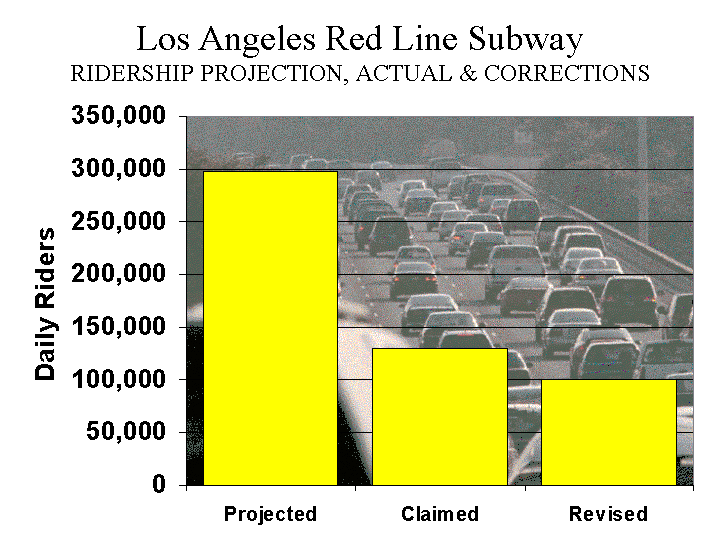
Number 65 - July 2003
By Wendell Cox
I suppose the news should have come as no surprise. For decades, transit agencies and regional planning agencies have claimed that their urban rail systems would carry many more people than actually rode when the lines opened. There was the fabled Miami rail line that was to have carried 239,000 daily passengers, and which now, nearly 20 years later, struggles to achieve 50,000. There was the Portland eastside light rail line, which was to have carried 45,000 daily riders, and which 10 years later remained at least a third short. And there was the Los Angeles Red Line subway, which was to have carried nearly 300,000 daily riders and was, as recently as December was reported to be carrying barely one-half that, despite building an additional spur not included in the original modeling. Which brings us to the point. It appears that transit agencies not only have a problem with projecting ridership, they also have a problem counting it once the systems have opened. Los Angeles is the case in point. Recently, the Los Angeles County Metropolitan Transportation Authority (a product of a merger between the Los Angeles County Transportation Commission, on which the author served, and the Southern California Rapid Transit District, where Tom Rubin was Chief Financial Officer) announced that it had overcounted ridership on the subway. Instead of 130,000 daily rides, the actual ridership level is less than 100,000. Now Los Angeles gets to move to the head of the class. Rather than missing on its subway projections by more than 55 percent, it now is more than 65 percent.

That's not the end of it. The agency also indicated that it has been overcounting bus ridership by approximately 100,000 per day. This is no small number. The 130,000 daily overcount of bus and rail riders is four times the total daily ridership on the Dallas or St. Louis light rail systems. It is more riders than the transit systems in Cincinnati, Phoenix, Kansas City or Buffalo carry. But LACMTA's overcount is nothing compared to the imagined overcounts of drivers who abandon their cars for the new rail lines. In Dallas, for example, the local monopoly newspaper, together with the transit agency, has been bragging for five years about all of the traffic taken off the local freeway system by the new light rail and commuter rail lines. They met the shock of Census data to the effect that transit commuting had dropped during the 1990s --- when the rail systems opened --- with questions about the accuracy of the Census data. Similarly, national transit officials have questioned Census data showing a large market share loss and a reduction in commuting by transit at the national level. All the while, they have touted ridership records so spectacular that one wonders when the rapidly emptying freeways will be dismantled. Never mind that the Census asked 12 million employees how they travel to work, and transit doesn't even count actual trips (transit estimates "boardings," which overstate ridership because people count each time they get on a transit vehicle, even if they board more than one on a single trip). Moreover, the Census Bureau has no interest in the outcome of its surveys --- they simply are seeking the most accurate possible numbers. Transit, it is fair to say, does have an interest in the numbers that it reports. Recently, a local newspaper article suggested that many people have abandoned their cars to ride the Red Line subway from the San Fernando Valley to downtown Los Angeles. If that is so, then a lot more have started driving. At Barham Boulevard, the midpoint of Cahuenga Pass, Caltrans reports traffic levels today that are higher than before the Red Line opened. The Los Angeles revelations call into question the veracity national transit data. Los Angeles transit managers are no barbarian invaders of a civilized transit world. They are among the most talented if not the most talented transit people in the nation. Spending over one billion dollars every year, it would seem that they would have the resources to get something so elementary as passenger counts right. Wendell Cox is principal of Wendell Cox Consultancy, an international demographics and transport firm located in the St. Louis area. He is a visiting professor at the Conservatoire National des Arts et Metiers in Paris (a national university granting degrees through the doctoral level). Mayor Tom Bradley appointed him to three terms on the Los Angeles County Transportation Commission (1977-1985). Speaker of the House Newt Gingrich appointed him to fill the unexpired term of New Jersey Governor Christine Todd Whitman on the Amtrak Reform Council (1999-2002).
Navigation & Publication Series
|